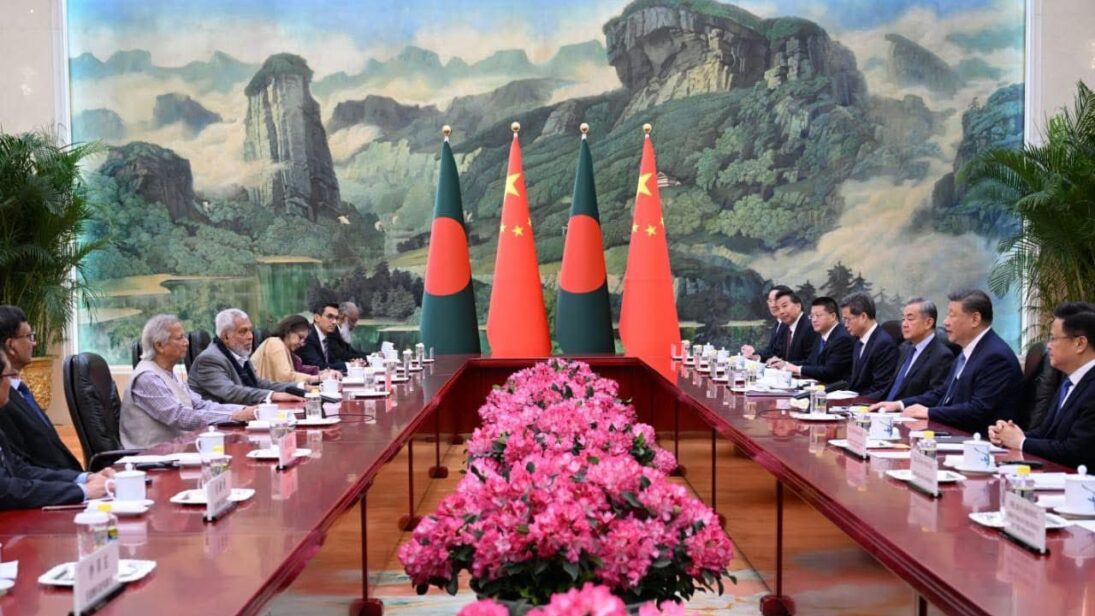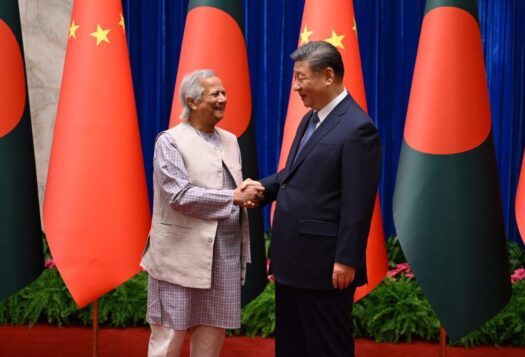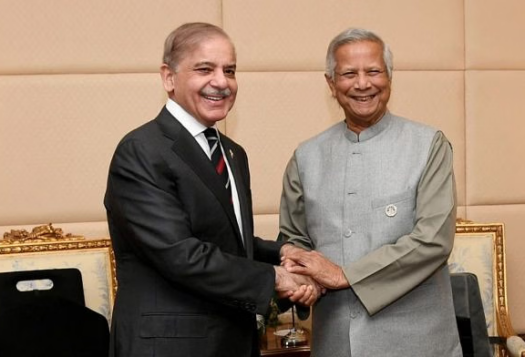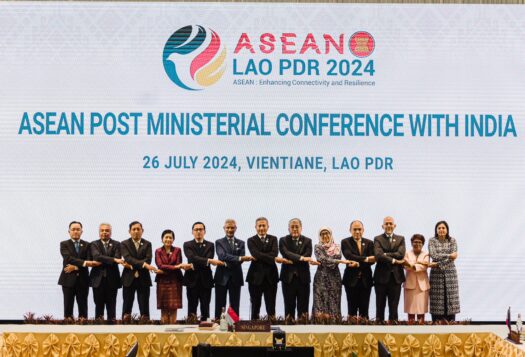
The recent visit to Beijing by Bangladesh Chief Adviser Muhammad Yunus marked a historic milestone in Bangladesh-China relations, commemorating the 50th anniversary of diplomatic ties between the two countries. Since the establishment of diplomatic relations in August 1975, China has remained a critical development partner for Bangladesh, and, today, China stands as Bangladesh’s largest trading and defense partner.
With the fall of former Prime Minister Sheikh Hasina—who had fostered a close alignment with New Delhi—Beijing sees an opportunity to deepen its influence in Bangladesh further. For Bangladesh, troubled relations with India make China an even more significant partner across several sectors. Yet, even as Bangladesh nurtures China as an important partner in its development journey, it is important for Dhaka to remain strategically autonomous and avoid becoming a pawn in the region’s geopolitical disputes.
Key Drivers of Cooperation
Located at the crossroads of South and Southeast Asia, Bangladesh serves as a strategic gateway connecting two of the world’s most dynamic regions. Providing crucial access to the Bay of Bengal for landlocked countries such as Nepal, Bhutan, and India’s northeastern states, China has long regarded Bangladesh as an important partner in its efforts to expand influence and economic ties in South Asia.
Although bilateral relations with Beijing expanded significantly during the Hasina regime, they occasionally faced setbacks, largely as a result of the government’s perceived strong alignment with New Delhi. With the interim government in Dhaka now signaling a desire to pursue an independent foreign policy and distance itself from India’s influence, China views this current moment as a golden opportunity to deepen its footprint in Bangladesh.
Following his visit to Beijing last month, Yunus said that Bangladesh has the opportunity to expand bilateral ties with China to collaboration beyond the economy. Toward that end, during the visit, Dhaka and Beijing signed nine instruments, including one agreement on economic and technical cooperation and eight MoUs covering cooperation on cultural heritage, news exchange, media, sports, healthcare, and more.
Trade and Investment
While bilateral trade relationship between Bangladesh and China has strengthened recent years, there is room to address imbalance. In 2018, China surpassed India as Bangladesh’s largest trading partner and since then, it has maintained its dominant position. In Fiscal Year 2024 alone, bilateral trade amounted to USD $18.5 billion.
Even as Bangladesh nurtures China as an important partner in its development journey, it is important for Dhaka to remain strategically autonomous and avoid becoming a pawn in the region’s geopolitical disputes.
Yet, while China is the primary source of Bangladesh’s imports, exports to China remain low, resulting in a substantial trade deficit. In the last fiscal year, this trade deficit marginally increased, reaching USD $16.45 billion. While China has granted 100 percent duty-free access to its markets for Bangladeshi products, this has not translated into a significant increase in exports. According to some experts, this is primarily due to a limited range of exportable goods, stringent value-addition requirements, and a lack of competitiveness in key sectors.
During his recent visit, Yunus attempted to find solutions to these challenges by promoting Bangladeshi exports and find greater market visibility for them. Dhaka and Beijing agreed to expedite the export of Bangladeshi products such as fresh mangoes and other agricultural and aquatic produce. Beijing has also welcomed Dhaka to make full use of platforms such as the China International Import Expo, China-South Asia Expo, and China International Supply Chain Expo, which will help Bangladeshi exporters market their products to Chinese consumers and businesses.
During the visit, Yunus also secured a commitment of USD $2.1 billion in Chinese investment, loans, and grants. The Bangladeshi delegation also pushed Chinese President Xi Jinping to encourage Chinese firms to move their manufacturing activities to Bangladesh. Such a move would not only help Chinese companies bypass increased tariffs imposed by the United States on Chinese exports but will also create jobs and foster industrial growth in Bangladesh. Next month, Chinese Commerce Minister Wang Wentao is set to visit Dhaka along with 200 investors in order to hopefully pit some of these plans into action.
Access to Affordable Healthcare
With a population of over 160 million, Bangladesh faces mounting pressure to modernize its healthcare sector and improve access to advanced medical treatment. Since affordable and high-quality healthcare remains limited in Bangladesh, many Bangladeshis have long sought medical care abroad, particularly in neighboring India. However, after the ouster of the Hasina regime and the bilateral tensions that followed, Indian visas have been difficult to obtain.
During his visit, Yunus attempted to remedy this problem by turning to Beijing on the healthcare front. China has already dedicated four Kunming hospitals for the treatment of Bangladeshi patients at the same moderate fees paid by local Chinese people, and both sides are also taking initiatives to expand affordable air travel to the Chinese city. Beijing has also pledged to build three specialized hospitals, including a 1,000-bed facility as a gift to Bangladesh. Such initiatives will also enhance people-to-people ties between the two countries.
Water Management
Yunus also hopes to revive the Teesta River Comprehensive Management and Restoration Project (TRCMRP) to ease Bangladesh’s water supply challenges. Running from India into Bangladesh, around 35 barrages have been built on the Indian side of the Teesta River, disrupting the river’s natural flow. As a consequence, in Bangladesh the river’s volume and consistency is diminished, causing overflow during the monsoon and underflow during the dry seasons, and impacting agriculture, livelihoods, and the overall environment.

In order to remedy this problem, the Hasina regime had partnered with Beijing to design the TRCMRP. Under the project, extensive drainage work was to be carried out along the 115-mile stretch of the Teesta River within Bangladesh, deepening the mid-river bed to improve water flow. A large reservoir was also to be constructed to store surplus monsoon water and ensure a reliable supply for irrigation during the dry season. However, in 2024, Hasina pivoted away from Beijing and preferred New Delhi instead to implement the project. During his visit, Yunus appeared to reverse that course, welcoming Chinese companies to participate in the project.
Rohingya Repatriation
Yunus’ visit also attempted to revive a pathway to resolving Bangladesh’s longstanding refugee crisis. The Rohingya refugee crisis continues to be one of Bangladesh’s most pressing diplomatic and humanitarian challenges, with over a million refugees living in camps in Cox’s Bazar and facing severe funding shortfalls. Bangladesh hopes to find a solution that would allow the refugees to be safely repatriated to Myanmar. Given its diplomatic capital in Myanmar, China has emerged as a key player in this effort.
During Yunus’ recent visit, China pledged to “provide support for the repatriation to the best of its capabilities”. Shortly after the visit, a potential breakthrough was achieved after Myanmar confirmed that 180,000 Rohingya refugees living in Bangladesh are eligible to return. However, experts argue that a realistic repatriation effort will depend on the success of a ceasefire between warring parties in Myanmar’s Rakhine State — most of whose territory is currently controlled by the rebel Arakan Army. Dhaka hopes that Beijing can act as a key mediator, given that it enjoys significant influence over the ruling military junta and strong ties with key EAOs, including the Arakan Army in Myanmar. However, challenges remain regarding the sustainability of any Chinese-brokered peace agreement due to the complexity of the ongoing civil war.
Preserving Bangladesh’s Strategic Autonomy
Yunus’ recent visit to China took bilateral relations between the two nations to a new height. Given Dhaka’s ongoing tensions with New Delhi over its continued refusal to extradite Hasina, Beijing has correctly seen the interim government’s rule as a window of opportunity to deepen its footprint in Bangladesh. However, Dhaka’s efforts to secure a stronger relationship with Beijing may add to skepticism in New Delhi and among partners in the West. While the economic and strategic rationale for cooperation with Beijing is strong, Bangladesh must balance partnership with China against regional geopolitical sensitives, in order to secure national interest while maintain strategic independence. In order to minimize the political risk of overreliance on any one partner, Dhaka should continue to diversify partners in the region, including reaching out to traditional partners, to ensure that it prioritizes its bilateral relations based on mutual interests. In particular, Dhaka should communicate that it seeks partnerships on a more equal footing, as opposed to client-benefactor relationships. It should also assure its partners that it is not seeking to take sides in broader geopolitical tussles.
In order to minimize the political risk of overreliance on any one partner, Dhaka should continue to diversify partners in the region, including reaching out to traditional partners, to ensure that it prioritizes its bilateral relations based on mutual interests.
While fostering closer relations with China or any other nation, Bangladesh must preserve its strategic autonomy and avoid becoming a pawn of either side in geopolitics. For instance, Dhaka should carefully navigate the opportunities presented by foreign investment while mitigating the risks of heavy debt dependency. In order to do so, it should cultivate a diversified network of strategic and economic partnerships to avoid over-dependence on any single partner. By pursuing policies that align closely with its national interests, Bangladesh can realize its vision of emerging as the “new Asian tiger” while benefiting from fruitful and mutually beneficial partnerships with multiple partners.
Views expressed are the author’s own and do not necessarily reflect the positions of South Asian Voices, the Stimson Center, or our supporters.
Also Read: The Bangladesh-Pakistan-China Triangle and India’s Strategic Dilemma
***
Image 1: Chief Adviser of the Government of Bangladesh via X
Image 2: Shafiul Islam Shaikot via Wikimedia Commons


